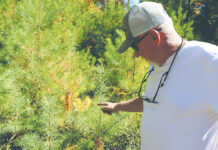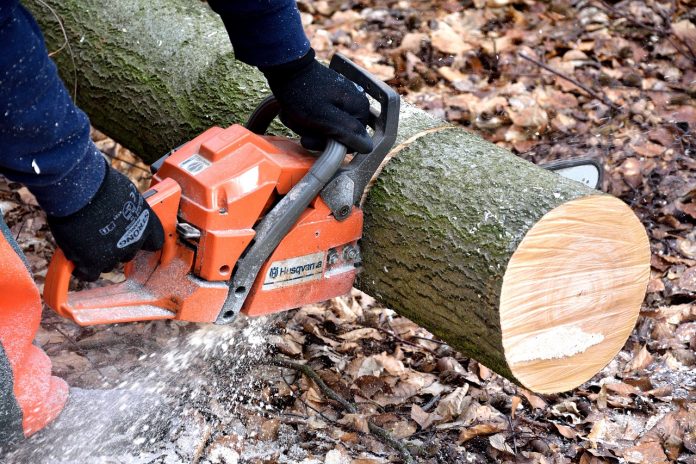I never really thought about the skill it takes to cut down a tree until I was faced with the challenge myself.
Growing up, my mom and dad both had their own chain saws. We cleared the land their house is built on ourselves. Even my younger brother learned how to operate a chain saw sometime during our youth.
Cutting down trees was so commonplace by the time I was in high school, I never really thought about it as a valued skill. Even now, my parents will spend weekends taking out trees that died over the summer or never really came back after last winter. As a result, I always assumed felling a tree was common sense.
Fast forward to my late 20s and suddenly cutting down trees — or even stumps — doesn’t seem so easy. The previous occupant of my house left a stump with limbs growing in the flower bed right next to the front porch. Since the day I moved in, I’ve hated that tree. Apparently, it was some kind of decorative cherry tree gone wild. It was trimmed back, but what remained was an eyesore.
It had to go
I knew it had to go. But I’m also realistic enough to realize I’m not comfortable operating a chain saw to remove even a stump. Obviously, I called my dad and had him take care of it. He’s good for things like that.
However, the whole experience got me thinking — felling trees is something I should know how to do if I want a rural existence.
Felling preparation
Before you even start your chain saw, you need to evaluate the tree you want to remove and decide whether or not you can do it safely. Consider these factors before you make your first cut:
- Check the diameter of the tree. If it’s more than twice the length of the saw bar, it’s going to require special cutting techniques and should be left to experienced specialists.
- Before choosing a felling direction, check the tree for lean. A slight lean can help place a tree; however, trees with a severe lean can be dangerous to fell because the tree will move in the leaning direction too quickly, splitting at the base and becoming what is known as a “barber’s chair,” which can fly upwards towards the operator.
- Determine the soundness of a tree before cutting it. This can be determined by looking for signs of rot, including loose bark, fine sawdust particles at the base of the tree and large holes. Take special care to examine the top to see whether there are any dead limbs or branches, that may fall while you’re cutting the tree, are hanging.
- Check the distribution of the tree’s crown. Large limbs, snow and ice accumulations and uneven distribution of the crown, can pull a tree in the weighted direction.
- Consider the direction and force of the wind before felling a tree. Wind is more pronounced on trees with large crowns. Avoid felling trees on very windy days.
- Evaluate the terrain in your working area. Determine its effect on the felling direction and to predetermine a safe escape route. You also want to be mindful of any hazards — other trees, buildings or power lines — in the area. If they do exist, you should hire an experienced worker to remove the tree.
- Clear the area around the base of the tree. It should be cleared before you begin cutting to allow greater freedom of movement and to make it easier to move away once the tree begins to fall.
- Pick a safe place to stand when the tree falls. Keep in mind a gust of wind or rotten spot in the trunk may cause the tree to fall in the wrong direction. The tree may bounce, kick backwards or roll once it hits the ground. It’s usually safe to position yourself behind a larger tree off to the side and away from the tree you are cutting. If you’re removing a tree on a hillside, you need to stand uphill of the tree.
How to fell a tree
If you’ve completed the preparation steps, and have determined you can remove the tree you desire safely, then follow these steps:

- On the side of the tree that faces the direction you want it to fall, you want to remove a wedge-shaped piece of trunk, known as the undercut. Only 1/4 to 1/3 of the tree’s diameter should be removed with the undercut. A conventional undercut is made by sawing the lower horizontal face first and then sawing the upper face down at an angle to meet it. A newer style of undercut features angled top and bottom faces, which form a 90-degree angle. The newer style offers a longer period of control over the tree’s fall because the faces don’t close until the tree is on the ground. Either way, make sure both cuts meet precisely.
Photo via University of Illinois Extension. - Once you’ve made your notch in the direction you want the tree to fall, you’re ready to put in the backcut on the opposite side of the tree. You want to start your horizontal backcut one to two inches higher than the “V” of your undercut. Make sure to stop before reaching the undercut, leaving about two inches of uncut wood remaining to create a hinge. The hinge helps guide the direction of the fall and helps keep the butt of the tree from leaving the ground and hitting the operator. On trees 16 inches or larger in diameter, you should make two extra side cuts to prevent splitting the butt of the log.
- If the tree is small enough (six to eight inches in diameter) that an assistant can push it in the desired felling direction, you may not need a wedge. However, both of you need to remain alert with a plan to leave the area without stumbling over each other when the tree starts to fall.
- Larger trees can be felled using wedges made of wood or plastic. Drive the wedge into the backcut behind the saw with a maul, forcing the tree in the desired direction until it begins to fall.
- Once the tree begins to fall, the operator should retreat in a diagonal direction, away from the fall. Be sure to use your predetermined escape route and keep your eye on the tree for any developing problems.
If felling a tree seems too complicated when considering the steps above, call an experienced professional or your dad. It works just fine for me.











